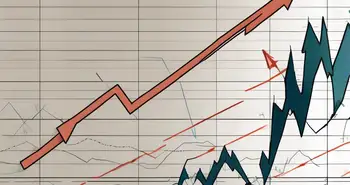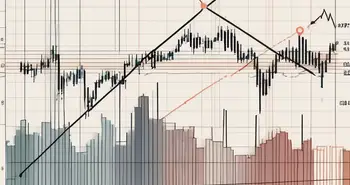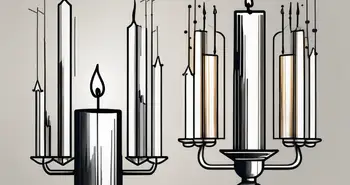Revealing the True Meaning of Wedge Patterns

Welcome to the fascinating world of wedge patterns! As an experienced trader and pattern analyst, I am thrilled to share with you the secrets behind these powerful formations. By understanding the basics, interpreting the patterns, and implementing effective strategies, you'll gain a valuable edge in your trading endeavors. So, let's dive in and uncover the hidden treasures of wedge patterns!
Understanding the Basics of Wedge Patterns
Before we delve into the intricacies of wedge patterns, let's start with the definition and importance of these formations. A wedge pattern is a technical analysis tool used by traders to identify potential trend reversals or continuations. Its significance lies in its ability to provide valuable insights into market sentiment and possible future price movements.
There are two main types of wedge patterns: the rising wedge and the falling wedge. The rising wedge pattern occurs when both the support and resistance lines are moving upward, gradually converging. Conversely, the falling wedge pattern exhibits a downward movement of both lines. While these patterns may appear similar, it's crucial to differentiate between them to make accurate predictions.
Traders often look for specific characteristics within wedge patterns to confirm their validity. These characteristics include decreasing trading volume as the pattern develops, indicating a potential breakout. Additionally, the duration of the pattern can vary, with some wedges forming over a few weeks and others spanning several months.
It's essential to consider the overall market context when analyzing wedge patterns. For instance, if a rising wedge forms after a prolonged uptrend, it could signal a potential reversal in the market sentiment. On the other hand, a falling wedge following a downtrend might indicate a possible trend continuation.
The Anatomy of a Wedge Pattern
Let's dissect the components that make up a wedge pattern. Starting with the rising wedge pattern, picture an upward-sloping support line and a resistance line that is also moving upward, but at a steeper angle. As time passes, these lines gradually converge, creating a narrowing shape. Conversely, in a falling wedge pattern, the support line slopes downward, while the resistance line declines at a steeper angle. These converging lines form the body of the wedge.
Understanding the psychology behind wedge patterns is crucial for traders. In a rising wedge pattern, the narrowing formation is a signaling factor of potential market exhaustion. As the price bounces between the support and resistance lines, it suggests the struggle between buyers and sellers. Traders must be cautious as a breakdown below the support line may indicate a trend reversal, leading to a bearish market movement.
On the other hand, a falling wedge pattern signifies a potential bullish reversal. As the price action reaches higher lows and lower highs within the wedge, it suggests a period of consolidation. Breakouts above the resistance line could indicate a bullish reversal, presenting an excellent opportunity for traders to capitalize on the upward movement.
Rising Wedge Pattern
In a rising wedge pattern, the narrowing formation is a signaling factor of potential market exhaustion. As the price bounces between the support and resistance lines, it suggests the struggle between buyers and sellers. Traders must be cautious as a breakdown below the support line may indicate a trend reversal, leading to a bearish market movement.
Traders often look for volume confirmation when trading wedge patterns. A decrease in trading volume as the pattern develops can indicate weakening momentum and potential for a breakout. Additionally, the length of time it takes for the pattern to form can provide insights into the strength of the impending price movement.
Falling Wedge Pattern
Conversely, a falling wedge pattern signifies a potential bullish reversal. As the price action reaches higher lows and lower highs within the wedge, it suggests a period of consolidation. Breakouts above the resistance line could indicate a bullish reversal, presenting an excellent opportunity for traders to capitalize on the upward movement.
It's essential for traders to consider the overall market context when analyzing wedge patterns. Factors such as broader market trends, economic indicators, and upcoming news events can influence the reliability of wedge pattern signals. By incorporating multiple technical and fundamental analysis tools, traders can enhance their decision-making process and improve their trading outcomes.
Interpreting Wedge Patterns
Spotting a wedge pattern in the market can be a game-changer for traders. But how can you identify it? Look for converging trend lines that create the typical triangular shape. These lines should have a clear and consistent slope in either an upwards or downwards direction. Additionally, volume analysis can provide valuable confirmation.
Once a wedge pattern has been identified, it's essential to decipher the signals it presents. Breakouts and breakdowns are the critical moments that traders should focus on. A breakout occurs when the price surpasses the resistance line, signaling a potential trend continuation. Conversely, a breakdown happens when the support line is breached, suggesting a possible reversal in the prevailing trend.
Traders often use wedge patterns as part of a broader technical analysis strategy. By combining this pattern with other indicators such as moving averages or oscillators, traders can strengthen their trading decisions. For example, if a wedge pattern forms near a key support level and coincides with oversold conditions on an oscillator, it may provide a stronger signal for a potential reversal.
Furthermore, the duration of a wedge pattern can also offer insights into its potential impact. A longer-term wedge formation, spanning several weeks or months, may indicate a more significant price movement upon breakout or breakdown. On the other hand, a shorter-term wedge pattern, developing over a few days or weeks, might lead to a more immediate but possibly less substantial price change.
Strategies for Trading with Wedge Patterns
Timing your entry and exit points is vital when trading with wedge patterns. Patience and precision are key. As the price reaches the apex of the wedge, it's crucial to wait for confirmation before taking action. This confirmation could be in the form of a breakout or breakdown, supported by volume analysis.
To manage the inherent risks, employing proper risk management techniques is imperative. Set stop-loss orders to protect against excessive losses in case of a false breakout or unexpected market movement. Additionally, consider trailing your stop-loss order to lock in profits as the price continues in your favor.
Common Mistakes and Misconceptions
False Breakouts in Wedge Patterns
One common mistake traders make is overreacting to false breakouts. It's crucial to remember that not every breakout signals a significant price movement. False breakouts can occur due to market manipulation or temporary shifts in supply and demand. Therefore, it's essential to wait for a confirmation candlestick or reliable follow-through before entering a trade.
Overreliance on Wedge Patterns
While wedge patterns are powerful tools, it's crucial not to solely base your trading decisions on them. Markets are complex, and relying on a single pattern might lead to missed opportunities or incorrect predictions. Always consider other technical indicators, fundamental analysis, and market sentiment to supplement your pattern analysis.
I vividly remember a particularly memorable trade when a rising wedge pattern formed on a currency pair I was closely monitoring. The price approached the apex of the wedge, and I patiently waited for confirmation. Suddenly, a breakout occurred, and the pair began a steep descent, resulting in substantial profits for my trade. This experience solidified my belief in the effectiveness of wedge patterns and the importance of timely execution.
FAQ: Frequently Asked Questions
What are wedge patterns?
Wedge patterns are technical analysis tools used by traders to identify potential trend reversals or continuations. They consist of converging trend lines, creating a triangular shape.
What is the difference between a rising wedge and a falling wedge pattern?
In a rising wedge pattern, both the support and resistance lines are moving upward, gradually converging. In a falling wedge pattern, the support line slopes downward, while the resistance line declines at a steeper angle.
How can I spot a wedge pattern?
To spot a wedge pattern, look for converging trend lines with a consistent slope. Pay attention to the triangular shape created by these lines and consider volume analysis for confirmation.
How do I trade with wedge patterns?
Timing your entry and exit points is critical when trading with wedge patterns. Wait for confirmation in the form of a breakout or breakdown, supported by volume analysis. Implement proper risk management techniques, such as setting stop-loss orders and trailing stops, to protect your capital.
Are wedge patterns infallible?
No pattern is infallible, and wedge patterns are no exception. False breakouts can occur, and overreliance on these patterns might lead to missed opportunities. Always consider other technical indicators, fundamental analysis, and market sentiment to supplement your pattern analysis.
Now armed with the secrets of wedge patterns, you're equipped to navigate the markets with confidence and precision. Remember, continuous learning and practice are essential for mastering the art of pattern analysis. Happy trading!
Ready to put your newfound knowledge of wedge patterns to the test? Join Morpher, the revolutionary trading platform that's changing the game with blockchain technology. Experience zero fees, infinite liquidity, and the freedom to trade a variety of assets, from stocks and crypto to unique markets like NFTs. With Morpher, you can start investing with just $1, enjoy up to 10x leverage, and trade with confidence knowing your funds are secure in your self-hosted wallet. Don't miss out on this innovative trading experience. Sign Up and Get Your Free Sign Up Bonus today and start trading on a platform as advanced as your strategies!

Disclaimer: All investments involve risk, and the past performance of a security, industry, sector, market, financial product, trading strategy, or individual’s trading does not guarantee future results or returns. Investors are fully responsible for any investment decisions they make. Such decisions should be based solely on an evaluation of their financial circumstances, investment objectives, risk tolerance, and liquidity needs. This post does not constitute investment advice.

Painless trading for everyone
Hundreds of markets all in one place - Apple, Bitcoin, Gold, Watches, NFTs, Sneakers and so much more.

Painless trading for everyone
Hundreds of markets all in one place - Apple, Bitcoin, Gold, Watches, NFTs, Sneakers and so much more.









